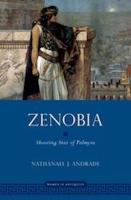
OUP (2018) h/b 284pp £22.99 (ISBN 9780190638818)
This volume by an expert in the Ancient Near East is intended for an academic and a general readership. This reviewer counts himself very much among the latter but the information about key sources and the list of abbreviations of scholarly publications together with the extensive bibliography point more towards the former. It is a recent addition to the range of publications in English that have in the last thirty focused on Zenobia and the short-lived ‘Palmyrene Empire’.
A. gives a useful introduction to the range of source material (often later in date and complicated) and to the nature of Palmyra and its culture as an important caravan and trading city with its variety of languages and cultures. He looks at its relationship with the eastern part of the Roman Empire, of which it was a distant part from the early 1st C BC-1s C AD, and its position between Rome and Parthia (later Sassanid Persia).
The subject matter is divided into the different phases of Zenobia’s life, each denoted by a star (e.g. Embryonic star, Rising star, etc.) but this maps out the trajectory of Zenobia’s life more systematically than is realistic. A. uses the general life-style of elite women to extrapolate and ‘elucidate aspects of Zenobia’s life that literary sources do not describe. This approach may not compensate for how little we can know about her personality and interiority but it can illuminate that material world that she experienced’ (p. 11). ‘Our aim is to craft a likeness of Zenobia that helps us glimpse the woman who lived’ (p. 12). We learn about extended families and kinship groups, and something on how Palmyra was organised, although we actually know little about Zenobia’s kin. Much of A.’s ‘account’ of Zenobia’s early life must be conjectural and speculative (see especially p. 67 on her early childhood years).
He is on safer ground when examining Palmyra’s links to the Roman state, its provision of military units (dealing with marauding nomads and protecting caravans), the effects of the Constitutio Antoniniana, and the grant by Caracalla of the status of colonia. This leads us on to the ‘Palmyrene Empire’ in the late 3rd C AD: the military campaigns of Odainath, Zenobia’s husband, and his assassination. This was followed by her seizure of power to ensure the succession of their son Wahballath. She took over extensive areas of the near East (including Egypt, Arabia and part of Anatolia), but was eventually defeated at the hands of Aurelian as he attempted to reunite the different regions of the Roman Empire. Even then Zenobia’s actual fate remains problematic, with some sources maintaining that she was executed after being paraded in Aurelian’s triumph, others stating that she was married off to a Roman senator and enjoyed retirement in a villa in Tivoli.
Zenobia has given rise over the centuries to an array of appearances in literature, art and even opera. The illustration on the dust-jacket is part of H.G. Schmalz’s ‘Zenobia’s last look on Palmyra’ of 1888, now in Adelaide in South Australia. (A full illustration of this along with a description of a major mid-nineteenth century sculpture of ‘Zenobia in Chains’ by Harriet Hosmer, and some references to other artworks can be found in Rex Winsbury’s Zenobia of Palmyra, Bloomsbury 2010). We are given a number of illustrations in A.’s work, with some enlargements of coins that enable us to appreciate their detail, and a number of funerary sculptures that unfortunately lack a scale. The maps on pp. 19 and 20 and the plan of Palmyra on p. 24 are too small-scale to be readily useful, and the photograph of the Great Colonnade and the precinct of the Temple of Bel (p. 25) cannot do justice to the monumentality of these constructions.
We are all well aware of the destruction at Palmyra caused by Isis, and A. includes photographs of a number of significant buildings that have been destroyed. For those who wish to take their studies further, there is some excellent help and guidance, with references to the ongoing ‘Palmyra Portrait Project’ and the ‘Syrian Heritage Initiative’ with websites listed for enabling access. He includes a simple guide to the Palmyrene language (a dialect of Aramaic) and a list of inscriptions referred to that relate to Odainath’s household: these are in Greek and/or transliterated Palmyrene, with translations provided. As mentioned above the bibliographical support is very impressive.
Stephen Kern
